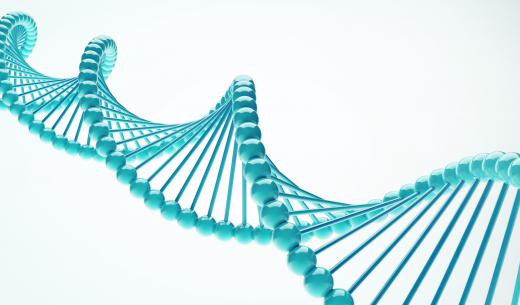What are Pseudogenes?
 Mary McMahon
Mary McMahon
Pseudogenes are sections of DNA which look like genes, but do not behave like genes, because they are unable to transcribe. Transcription is the first step in gene expression, and if a segment of DNA is unable to perform transcription, it is non-functional. Because pseudogenes are nonfunctional, some people lump them with so-called “junk DNA” which performs no function, but because they possess some traits associated with genes, they are of great scientific interest. Just because they don't work, in other words, doesn't mean that they have nothing to say.
Several processes can result in the formation of a pseudogene. Sometimes, a mutation causes a gene to become inactive, damaging the DNA so that it is no longer capable of transcription, and the mutation can be passed down and amplified in certain populations. These pseudogenes are known as “disabled.” If enough of a population has the mutation, eventually the gene will stop expressing in that population altogether, causing a particular genetic trait to vanish.

Pseudogenes can also be processed, the result of of mRNA which retrotransposes into DNA and then inserts itself into the DNA. The segment of DNA will be nonfunctional, but it may look like a complete gene. Nonprocessed pseudogenes occur when genes replicate and one of the replicas becomes nonfunctional due to a mutation. Over the course of generations, the DNA will gradually break down even further, eventually turning into true junk DNA.
The primary reason that pseudogenes are of interest is because they can reflect evolutionary shifts and reveal information about the relationships between various organisms. For example, two species of big cat can be traced to common ancestors with the use of pseudogenes, with researchers looking for similar lengths of genetic material to determine when the species started to split off. Pseudogenes can also be used to trade the evolutionary history of an organism, with researchers looking for inactive genes which code for traits which no longer appear. Pseudogenes could be compared to the information encoded in the side of film; it can't be seen in the finished picture, but it provides valuable information for those who know where to look.
By definition, this genetic material is nonfunctional. However, pseudogene activation has been known to occur, most commonly in malignancies where something triggers the activation of the defunct gene. Researchers have noted that pseudogenes are sometimes involved in the development of certain cancers, making the activation process of interest to people working in cancer treatment and prevention.
AS FEATURED ON:
AS FEATURED ON:











Discussion Comments
@browncoat - I know that often pseudogene research leads to more information for cancer sufferers and can lead to really interesting and important discoveries about evolution and so forth.
But it still creeps me out to think of those poor chicken embryos. I know they don't let them develop all that far, but the idea of something being mutated in order to study it just doesn't seem right to me.
Most of the time when pseudogenes are activated it leads to something bad for the creature, because those genes became deactivated in the population for a reason.
@umbra21 - I'm not sure that it is all pseudogenes that they are thinking about in that particular possible experiment.
I do know that they have occasionally come across chickens with tooth buds, which had to come from an earlier time.
Unfortunately, at the moment this kind of tinkering with genes is still very experimental, so it's not like they can just reach into the chicken geonome and decide which bits belong to dinosaurs and switch them on.
I believe the plan (which at the moment is only wishful thinking, as they have no funding) was simply to bombard chicken genes with radiation and hope that a mutation they could use would develop.
It's fascinating how scientists can trace evolution through our DNA. The use of junk genes and pseudogenes are a couple of examples of this.
What I find interesting is that even though pseudogenes by definition don't express themselves, they could possibly be made to express themselves, perhaps bringing an ancient trait to a modern creature.
I've heard that this is what one scientist wants to do with chickens. Birds are the modern descendants of dinosaurs, so, in theory, a chicken might still have many of the genes a dinosaur did, that simply don't express themselves.
If they could start making those genes work again, they could recreate some traits from those ancient creatures. Wouldn't that be amazing?
Post your comments